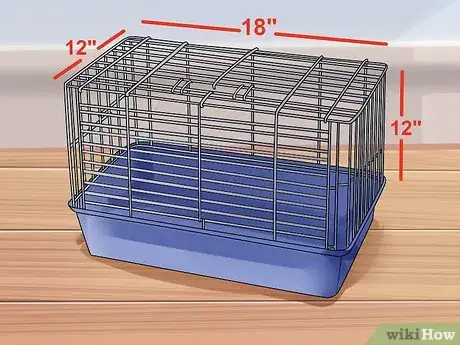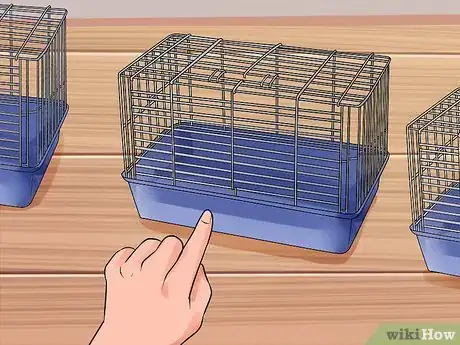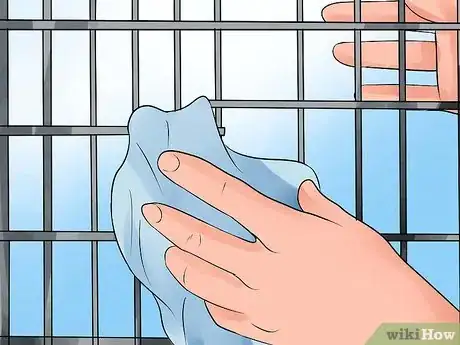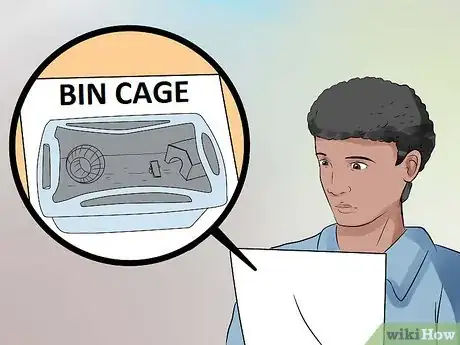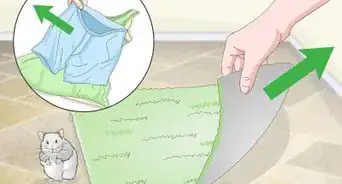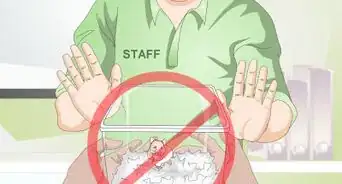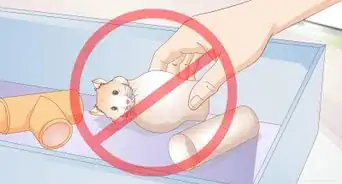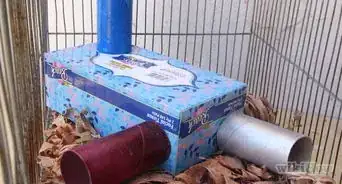This article was co-authored by Pippa Elliott, MRCVS. Dr. Elliott, BVMS, MRCVS is a veterinarian with over 30 years of experience in veterinary surgery and companion animal practice. She graduated from the University of Glasgow in 1987 with a degree in veterinary medicine and surgery. She has worked at the same animal clinic in her hometown for over 20 years.
This article has been viewed 99,279 times.
Choosing the right hamster cage will have a positive effect on your hamster’s overall health and quality of life. In fact, the cage is probably is one of the most important investments in your hamster that you will make.[1] There are many different types and layouts of cages, as well as several factors to consider when selecting a cage (e.g., species of hamster, safety of cage, size), so you should take the time to learn about each cage option before deciding which one will work best for your hamster.
Steps
Choosing a Good Cage for Your Hamster
-
1Select the right-sized cage for your hamster. The recommended minimum size for your hamster’s cage is at least 18 inches (width) x 13 inches (height) x 25 inches (length), which is equal to 450 square inch floor space, which is the minimum for humanely housing a hamster of any type. The 13 inch height is to allows you to fit a 10-12 inch wheel for a Syrian hamster. [2] However, bigger is always better, since your hamster will want plenty of space to run, climb, and play.[3] Your hamster will also want to have separate areas to go to the bathroom, sleep, and store food, which will necessitate a very spacious cage.[4]
- If you will be housing more than one hamster in the same cage, the cage will need to be even bigger to give each hamster plenty of room. A good guideline to follow is the minimum floor space times the number of hamsters to be put in the cage
- Some Dwarf hamsters can be housed together in pairs, but only in same-sex pairs to prevent breeding. Roborovski and Russian Campbells are the best hamsters to be housed in pairs. [5] [6]
- Keep in mind that Syrian hamsters are very territorial and should never be housed together.[7] However, they can be housed near each other in separate cages, so long as they can't be disturbed by each others presence. So a rule of thumb should be to separate their cage by 4-6 inches.
-
2Select a cage that is well ventilated. A poorly ventilated cage can lead to the build-up of ammonia, which is toxic to your hamster and can lead to respiratory problems.[8] Poorly ventilated cages can also lead to bacterial growth, which could also make your hamster sick.[9] Wire cages tend be very well ventilated, but aquariums and plastic hamster cages are often poorly ventilated.
- Your hamster may start to have trouble breathing if his aquarium or plastic cage is not well ventilated. If you notice that he is not breathing properly or looks unwell in general (not eating, playing as much or has physical signs of illness), consider cleaning his cage to remove soiled bedding. You may also want to consider purchasing a wire cage, that is of adequate size.
Advertisement -
3Choose a cage that is easy to clean. You will need clean your hamster’s cage once or twice a week depending on your cage, so you will want a cage that will not be too difficult to clean. Wire cages are probably the easiest type of cage to clean. Aquariums and plastic cages may need more frequent cleaning because of their poor ventilation, but this most likely won't be an issue if your cage is the minimum size or above.[10] Plastic cages are the most difficult to clean, since they often have many different components, are multi-level, and have twists and turns that could be a challenge for you to reach.
- No matter which type of cage you have, it would be helpful to have a secondary, smaller cage that you can put your hamster in while you are cleaning his main cage or away travelling with your hamster. [11]
-
4Choose a cage that has a solid plastic floor. Your hamster’s nails could get caught in a grated or wire floor, which often leads to foot injuries. Also, solid plastic floors are easier to clean than grated floors.[12]
-
5Determine which cage type would be ideal for your species of hamster. If you have a Syrian hamster, you will likely be fine with any type of cage, as long as it is the minimum size or larger and has places for him to play, sleep, and eat. However, if you have a smaller species of hamster (i.e., Chinese, Dwarf), you will need to be more careful with the type of cage you choose. For example, you will need to pay special attention to the spacing between the wires of a wire cage (no more than 1/2 inch of spacing), since a tiny hamster could squeeze through those spaces.[13]
- An aquarium or plastic cage may be better for your Chinese or dwarf hamster, since he would not be able to escape easily.
-
6Select a cage that fits your budget. The fact that your hamster’s cage is an important investment does not mean that you have to find the most expensive one that you can find. Small wire cages tend to be inexpensive, but wire cages of the minimum size or more are extremely costly. Plastic cages are also expensive, and most of the time don't even come close to the minimum cage size. Aquariums or bin cages can usually be your best bet.[14]
Learning About Hamster Cages
-
1Familiarize yourself with good wire hamster cages. A wire cage is a popular cage type for hamsters but usually is not big enough, so when looking for wire cages often rat cages with 1/2 inch spacing can work aswell as large hamster cages. A wire cage usually has a detachable base made of solid plastic.[15] The horizontal bars are ideal for hanging toys and chews.[16]
- Big wire cages are more suitable for Syrian hamsters, since they are relatively large and would not be able to squeeze between the wires.[17]
- Be aware that your hamster could gnaw on the wires,- if not given chews and toys-, which could lead to various dental problems that may need veterinary care.
-
2Learn about plastic hamster cages. Plastic hamster cages are multi-level, with tunnels and other areas that your hamster can run through and play in. In addition to being visually appealing (plastic cages are very colorful), plastic cages can be good for a dwarf hamster, since his small size would allow him to easily run through the twists and turns of the tunnels.[18]
- It can be fun to watch your hamster run through the cage.
- A plastic cage is not ideal if you have a large hamster, since he could get stuck in the tunnels.[19]
- If you have a dwarf hamster, he could easily hide in the small nooks and crannies of the cage, making him hard to find.
- Most plastic cages are too small alone and can only be used as attachment cages to a cage of the minimum size.[20]
- Plastic hamster cages should not have any edges that your hamster could gnaw on.[21]
-
3Consider the pros and cons of aquariums. Aquariums are not specifically made for hamsters, but could be an ideal housing option for your hamster. They are typically made of either solid glass or plexi-glass, which makes them very sturdy and easy to see through.[22] To keep your hamster from escaping, the aquarium should be covered with a well-fitted mesh top.[23] You may need to purchase this separately at your local pet store.
- The minimum size aquarium that you should have for your hamster is 30-40 gallons depending on the specific aquarium. Just be sure to have the floorspace be of the minimum size or bigger. [24]
- An aquarium would be ideal if you have a dwarf or Chinese hamster.[25]
- Aquariums have a few disadvantages, such as being heavy and having poor ventilation.
- Since aquariums are not hamster-specific, you would need to buy extra items to place inside of it, such as tunnels and ladders.[26]
EXPERT TIPDr. Elliott, BVMS, MRCVS is a veterinarian with over 30 years of experience in veterinary surgery and companion animal practice. She graduated from the University of Glasgow in 1987 with a degree in veterinary medicine and surgery. She has worked at the same animal clinic in her hometown for over 20 years.Veterinarian
 Pippa Elliott, MRCVS
Pippa Elliott, MRCVS
VeterinarianSafety Notice: If you do choose an aquarium tank, never place it in full sunlight. An aquarium tank will quickly become overheated in direct sunlight and the resulting heat stroke can kill a hamster in as little as 20 minutes.
-
4Learn about bin cages. Bin cages are cages that you can design and make yourself. The freedom to be able to design these cages yourself is a major advantage. Bin cages are usually much cheaper to make than it is to buy a proper sized store bought cage, but bin cages may not look as visually appealing as other cage types.
Expert Q&A
-
QuestionHamsters in the wild run 5-8 miles a night so don't they need lots of space?
 Pippa Elliott, MRCVSDr. Elliott, BVMS, MRCVS is a veterinarian with over 30 years of experience in veterinary surgery and companion animal practice. She graduated from the University of Glasgow in 1987 with a degree in veterinary medicine and surgery. She has worked at the same animal clinic in her hometown for over 20 years.
Pippa Elliott, MRCVSDr. Elliott, BVMS, MRCVS is a veterinarian with over 30 years of experience in veterinary surgery and companion animal practice. She graduated from the University of Glasgow in 1987 with a degree in veterinary medicine and surgery. She has worked at the same animal clinic in her hometown for over 20 years.
Veterinarian Absolutely! The minimum size recommendations are just that - a recommendation. Some experts advise at least 1 meter square of floor space. But just as important is a chance for the hamster to display normal exploratory behaviors, to digging, forage around, and trundle from space to space, which is why modular hamster cages are a good idea. In addition, a hamster wheel and handling the hamster are important means of encouraging exercise.
Absolutely! The minimum size recommendations are just that - a recommendation. Some experts advise at least 1 meter square of floor space. But just as important is a chance for the hamster to display normal exploratory behaviors, to digging, forage around, and trundle from space to space, which is why modular hamster cages are a good idea. In addition, a hamster wheel and handling the hamster are important means of encouraging exercise.
Warnings
- Ammonia is toxic to your hamster and can cause serious respiratory problems.[30] Cleaning his cage regularly will help keep ammonia from building up in his cage.⧼thumbs_response⧽
- Your hamster may injure himself in a wire cage if he falls while climbing up the wires. If you notice that he has fallen and injured himself, take him to your veterinarian for treatment.⧼thumbs_response⧽
References
- ↑ http://www.humanesociety.org/animals/hamsters/tips/hamster_housing.html
- ↑ http://www.smallanimalchannel.com/hamsters/hamster-housing/ideal-hamster-cage.aspx
- ↑ http://www.smallanimalchannel.com/hamsters/hamster-housing/ideal-hamster-cage.aspx
- ↑ http://www.humanesociety.org/animals/hamsters/tips/hamster_housing.html
- ↑ https://www.aspca.org/pet-care/small-pet-care/hamster-care
- ↑ http://www.humanesociety.org/animals/hamsters/tips/hamster_housing.html
- ↑ http://www.humanesociety.org/animals/hamsters/tips/hamster_housing.html
- ↑ http://www.smallanimalchannel.com/hamsters/hamster-housing/ideal-hamster-cage.aspx
- ↑ http://www.humanesociety.org/animals/hamsters/tips/hamster_housing.html
- ↑ http://www.smallanimalchannel.com/hamsters/hamster-housing/ideal-hamster-cage.aspx
- ↑ http://www.smallanimalchannel.com/hamsters/hamster-housing/ideal-hamster-cage.aspx
- ↑ http://www.smallanimalchannel.com/hamsters/hamster-housing/ideal-hamster-cage.aspx
- ↑ http://www.humanesociety.org/animals/hamsters/tips/hamster_housing.html
- ↑ https://www.aspca.org/pet-care/small-pet-care/hamster-care
- ↑ http://www.humanesociety.org/animals/hamsters/tips/hamster_housing.html
- ↑ http://www.smallanimalchannel.com/hamsters/hamster-housing/ideal-hamster-cage.aspx
- ↑ http://www.humanesociety.org/animals/hamsters/tips/hamster_housing.html
- ↑ http://www.humanesociety.org/animals/hamsters/tips/hamster_housing.html
- ↑ http://www.smallanimalchannel.com/hamsters/hamster-housing/ideal-hamster-cage.aspx
- ↑ http://www.humanesociety.org/animals/hamsters/tips/hamster_housing.html
- ↑ http://www.smallanimalchannel.com/hamsters/hamster-housing/ideal-hamster-cage.aspx
- ↑ http://www.humanesociety.org/animals/hamsters/tips/hamster_housing.html
- ↑ http://www.humanesociety.org/animals/hamsters/tips/hamster_housing.html
- ↑ http://www.smallanimalchannel.com/hamsters/hamster-housing/ideal-hamster-cage.aspx
- ↑ http://www.smallanimalchannel.com/hamsters/hamster-housing/ideal-hamster-cage.aspx
- ↑ http://www.smallanimalchannel.com/hamsters/hamster-housing/ideal-hamster-cage.aspx
- ↑ http://www.smallanimalchannel.com/hamsters/hamster-housing/ideal-hamster-cage.aspx
- ↑ http://www.smallanimalchannel.com/hamsters/hamster-housing/ideal-hamster-cage.aspx
- ↑ http://www.smallanimalchannel.com/hamsters/hamster-housing/ideal-hamster-cage.aspx
- ↑ http://www.smallanimalchannel.com/hamsters/hamster-housing/ideal-hamster-cage.aspx
